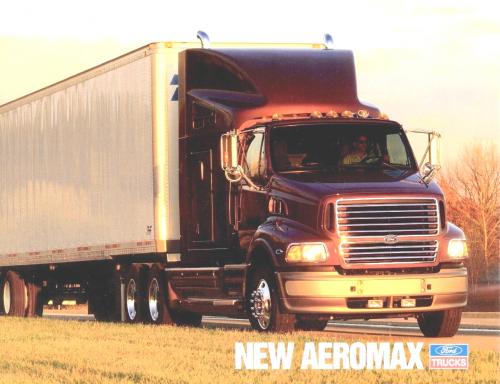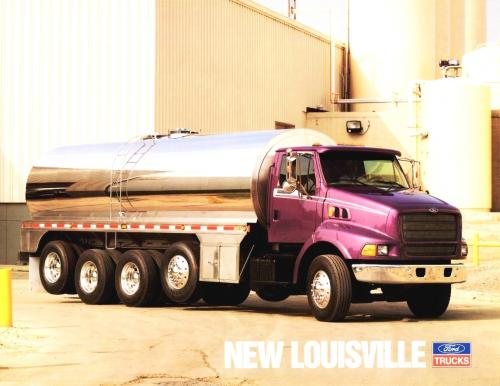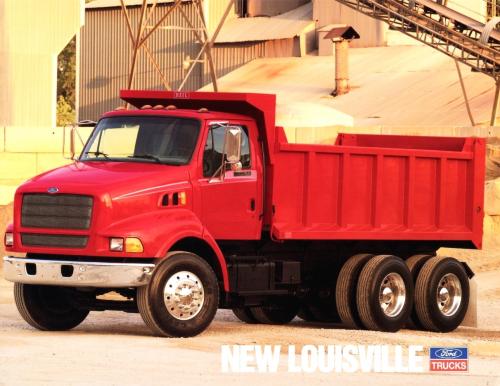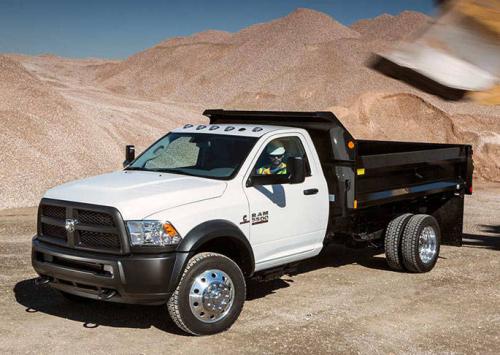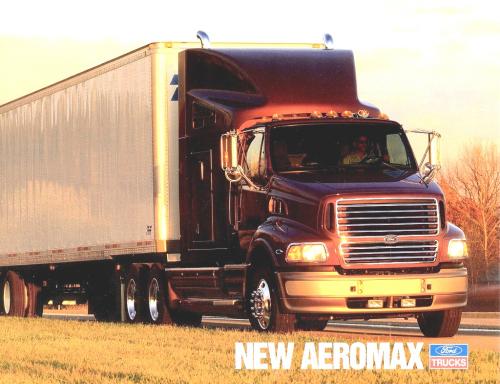
kscarbel2
Moderator-
Posts
18,541 -
Joined
-
Days Won
112
Content Type
Profiles
Forums
Gallery
Events
Blogs
BMT Wiki
Collections
Store
Everything posted by kscarbel2
-
PLASTIC HELPS FORD CUT WEIGHT IN NEW CLASS 8 Automotive News / December 18, 1995 Ford's new heavyweight has turned to plastic to shed some pounds before competing in the crowded Class 8 arena. The AeroMax 9500, the first new Class 8 tractor from Ford Motor Co. in 25 years, contains 450 pounds of sheet molding composite, a plastic also known as SMC. It replaces steel and other composite materials in a variety of body applications on the new AeroMax. 'That's a whale of a lot of SMC,' said Jim Grzelak, sales engineer at Eagle-Picher Automotive, an SMC supplier. 'It's the most used on any vehicle in the U.S., and we believe, the most on any vehicle in the world.' SMC - a combination of resin, glass and filler - has been used primarily for body panels in cars, trucks and commercial vehicles. SMC also is showing up as structural parts, such as the radiator support assembly on the 1996 Ford Taurus. It is sought by car and truck makers to shave weight from vehicle parts, said Erin Millerschin, program director of SMC Automotive Alliance, an association of 30 molders and raw materials suppliers. SMC is durable, doesn't rust, and resists dents and dings, she said. Goodyear Tire and Rubber Co. supplied SMC for the AeroMax 9500's hood, fenders, air-intake grille and cowl side panels. Eagle-Picher provides its plastic doors, roof, chassis fairings and side air deflector assemblies. Previously, it was common to find about 175 to 180 pounds of SMC on heavy-duty trucks, primarily for hoods and front fender extensions, Grzelak said. In contrast, the Lincoln Continental has about 35 pounds of SMC, using the plastic for the hood, decklid and taillight housing. By using 450 pounds, Ford is showing its confidence in SMC's durability, said Roger Schwartz, Eagle-Picher vice president of automotive sales. It is not unusual for heavy-duty tractors to rack up more than 1 million miles as they crisscross the country hauling their freight. Production of the new AeroMax will begin today at Ford's Kentucky Truck Plant. FOCUSED DESIGN AeroMax was designed specifically as an over-the-road tractor, a Class 8 that pulls a trailer over long distances. Production of its sister - the Ford Louisville - a separate new line of vocational trucks and tractors, also begins today at the same plant. The Louisville was designed for day fleets and short-haul drivers. The Kentucky Truck Plant already has built 60 new AeroMax and Louisville trucks and tractors this year for demonstration purposes in truck fleets. One of those models will be on display alongside its cars, pickups and vans during the North American International Auto Show in Detroit Jan. 6-15 and at the Chicago auto show Feb. 10-18. 'We will show the world how Ford is a full-line manufacturer, from small cars to HN80s,' the code-name for AeroMax, said Andy Jacobson, design director for Ford Commercial Trucks. A SHARK-BITE A chunk of the AeroMax will be cut away on the passenger side so that auto show patrons can get a good look at the interior. 'We call it the shark-bite look,' said Glenn Ray, a spokesman at the Commercial Truck Vehicle Center. 'It will be a magnet at our exhibit.' There presently are 97 Ford dealers in the United States that carry car, light-truck and commercial-truck products. Those dealers must meet additional Ford requirements for diesel engine maintenance and service. The new trucks and tractors eventually will replace Ford's aging L series, introduced in 1970. During the first phase of production, the tractors and trucks will be offered in a 113-inch bumper-to-back-of-cab medium conventional length. A long conventional, 122-inch bumper-to-back-of-cab length, will be offered later this year. 'It's not just good-looking, but very functional,' said John Sakioka, chief program engineer. Sakioka said the improved aerodynamic shape of the trucks are expected to boost fuel efficiency by up to 5 percent over the comparable L-Series models. ----------------------------------------------------------------------------------------------------------------------- SMC GETS BIG PLAY IN FORD'S BIG TRUCK Plastic News / January 15, 2015 Ford's new heavyweight has turned to plastic to shed some pounds before competing in the crowded arena of large trucks. The AeroMax 9500 from Ford Motor Co. contains 450 pounds of sheet molding compound (SMC), replacing steel and other composite materials in a variety of body applications. ``That's a whale of a lot of SMC,'' said Jim Grzelak, sales engineer at Eagle-Picher Automotive*, an SMC supplier. ``It's the most used on any vehicle in the U.S., and we believe, the most on any vehicle in the world.'' * Eagle-Picher sold its SMC business to Meridian in 1997, who sold it to Magna Int’l subsidiary Decoma Composites in 2009, who sold it to Continental Structural Plastics in 2014. SMC - a combination of resin, glass and filler - has been used primarily for body panels in cars, trucks and commercial vehicles. SMC also is showing up as structural parts, such as the radiator support assembly on the 1996 Ford Taurus. It is sought by car and truck makers to shave weight from vehicle parts, said Erin Millerschin, program director of SMC Auto-motive Alliance, an association of 30 molders and raw materials suppliers. Goodyear Tire and Rubber Co. supplied SMC for the AeroMax 9500's hood, fenders, air-intake grille and cowl side panels. Eagle-Picher's Grabill, Indiana plant supplies the doors and aerodynamic parts like the air foil above the roof and the fairing components such as the long piece extending along each side of the chassis. The AeroMax's huge instrument panel is supplied by Ford's plastics plant in Saline, Mich., and interior trim comes from Eagle-Picher. Previously, it was common to find about 175-180 pounds of SMC on heavy-duty trucks, primarily for hoods and front fender extensions, Grzelak said. By using 450 pounds, Ford is showing its confidence in the durability of SMC, said Roger Schwartz, Eagle-Picher vice president of automotive sales. It is not unusual for heavy-duty tractors to rack up more than 1 million miles as they crisscross the country hauling their freight. Production of the new AeroMax began last month at Ford's Kentucky Truck Plant. AeroMax 9500 is Ford's first new Class 8 tractor in 25 years. Class 8 tractors tip the scale at more than 33,001 pounds in gross vehicle weight. Ron Robbins, director of marketing and sales for Ford's commercial trucks, said, ``Truck sales in 1996 will be less than in 1995 but could be the second-best in history.'' He said 580 orders are in hand for the new AeroMax. The Kentucky plant has annual capacity for 42,000 AeroMax units.
-
Heavy Duty Ford Rolls Out New Long-haul Trucks Chicago Tribune / December 31, 1995 LOUISVILLE — The garnet-red AeroMax sleeper was out on a brief road test, but its successor on the line, a less ostentatious white Ford Class 8 truck with 10-speed transmission, sat quietly on the plant floor. Only a week before Christmas, it had been a big morning for the new Ford products, the first of redesigned long-distance runners and shorter-haul work trucks to come out of the mammoth Louisville plant in more than 25 years. Job 2 wore the CF graphics for one of Ford's major customers, Consolidated Freightways. An hour before Job 1 crossed the staging area, hundreds of the 4,800 women and men of the Louisville team had begun gathering in a open area to pay homage to the newest of the many trucks they build here. Musicians belted out "I Feel Lucky Today." Plant management, local politicians and UAW Local 862 Chairman Bob Breedlove gave brief talks. Then the engines roared, the air horns blared and the red AeroMax and the white cab crossed the stage. They were followed by a bright-red Louisville pulling food donated by employees for Dare to Care's charitable distribution. The sprawling Kentucky Truck Plant has the brawn to match its products. The largest truck plant in North America, according to Ford, the plant has 5 million square feet, or 100 acres, under roof. This is larger than 400 football fields. Ford recently invested $650 million in a 1-million-square-foot expansion and hired 1,400 employees for a second shift producing light commercial trucks. The new Louisville and AeroMax, which will be showcased in the Ford display at the Chicago Auto Show Feb. 10 through 18 in McCormick Place, will replace the L-series of heavy trucks. Ford said it intends to continue building the L-series until late next year. Because no one was talking price on the new line of heavies, there was speculation that the older L-series is more affordable and will still have customers. These vehicles are in Classes 7 and 8. Class 7 includes trucks with a gross vehicle weight of more than 26,000 pounds; Class 8 trucks have gross vehicle weight ratings of more than 33,000 pounds. The gross vehicle weight rating is the total weight of a "straight," or short-haul, truck when it is loaded. The gross combined weight ratings describe the tractor-trailer style pulling its maximum cargo. The weight ratings reflect the vehicles' pulling and stopping power, said Ford spokesman Tom Morrisey. The new AeroMax gross combined weight rating ranges from 75,000 pounds in the mid-range diesel-powered 4 X 2 Louisville to 138,000 pounds in the premium-diesel-powered Louisville with a 6 X 4 wheel configuration. The 4 in 4 X 2 refers to the number of driving wheels (these trucks are all rear-drive); the 2 is the number of steering wheels. In a 6 X 4, there are six driving wheels and four steering wheels. The Louisville will offer truck buyers a choice of 115 engines, ranging from a 210-horsepower Ford mid-range diesel to a 500-h.p. Cummins diesel. Seventeen transmissions are available to buyer of midrange diesels, those with lower horsepower for less-demanding jobs, and 68 for customers who need premium-diesel trucks, which do the heavy jobs that need more horsepower and torque, Ford said. "The torque rating is generally more important than the horsepower rating," said Ford's Morrisey. "The torque moves the weight; horsepower affects speed and is useful on grades." Engine makers include Caterpillar, Cummins, Detroit Diesel and Ford. The Cummins 500-h.p. model produces 1,650 lb-ft. of torque at 2,100 r.p.m. engine speed. There will be 63 fuel tank choices for Louisville buyers from a 55-gallon steel rectangular single tank to cylindrical polished-aluminum duals that hold 150 gallons each. Other major makers of these largest trucks include Chevrolet, Freightliner, GMC, Kenworth, Mack, Navistar, Peterbilt and Volvo/GM Heavy. Navistar is the heavy among the heavies. Its sales last year of close to 76,000 units accounted for 27 percent of the market. Freightliner was second, with 50,625 units, about one-fifth of the 283,854 heavies sold. In 1994, Ford truck dealers sold 48,742 heavies. Ford hopes to increase its share of the heavy truck market--now about 10 percent--in 1996. The competition is offering improved models as well, Robbins said, and customers aren't always brand-loyal. "We had hoped to build Job 1 back in July, but there were some things we needed to work out," said Ron Robbins, director of sales and marketing, Commercial Truck Vehicle Center. There's a 3-year/350,000-mile warranty at stake. Working around the clock, some trucks put those miles on in no time. Some, such as the red AeroMax sleeper, with its comfortable bunk space likely will yearn to see the Pacific Coast one week, then visit Texas before heading Northeast. Ford knew its heavy trucks needed more than a bold new grille to compete in a difficult, high-stakes market. Spokesman Glenn Ray said the company had been using models for design based on 50-year-old military statistics. Male drivers are bigger now. Ages vary, and there are increasing numbers of women driving and/or going along on trips. They are shorter, weigh less and have needs and requests Ford has tried to address, Ray said, such as increasing the seat travel and moving instruments closer. The Class 8 truck ready for Consolidated Freightways has two lower "steps," each about 16 inches apart, followed by the final step into the cab. The Louisville work truck has nine inches of seat track travel and a cab that's four inches longer than most trucks in the industry, said Ford spokesman Glenn Ray. The standard cab size is 113 inches long, bumper to back of the cab. Ford said a 122-inch cab is coming. Lightweight steel is the current cab material. An optional aluminum cab is promised for "future generations." The wheel is right at hand. A serious-looking 10-speed transmission stick is on the floor between the two bucket. The clutch that activates it is a huge pedal better depressed by a boot or heavy shoe than a ballet slipper. Ford said it worked diligently to make its instrument panel and other interior features driver-friendly. Drivers participated in design exercises in which they got to place gauges and buttons where they wanted them. The manual crank side windows of the CF rig are designed to dip down in the areas of the outside mirrors, improving visibility. .
-
Comfort is the Key to Ford's New Louisville Automotive News / June 26, 1995 Louisville, KY. - What's the highest compliment someone could pay Ford Motor Co. about its new Louisville heavy-duty work truck? That it's more powerful? More rugged? Comes in nice colors? Try that it is much more comfortable for the driver. At a press preview for the Class 7 and 8 trucks, which will eventually replace the 25-year-old L series design, Ford executives stressed that the Louisville was designed from the inside out. Why? Because driver comfort is key to trucking companies keeping drivers, said John Ochs, a Ford spokesman. Gang of 67 So Ford assembled a group of 67 commercial fleet truck owners, not all of them owners of Ford trucks, to serve as a sounding board for the designers and engineers developing the Louisville. In addition, Ford brought in more than 5,000 truck drivers to evaluate designs, sit in interior styling bucks and place gauges and controls to their liking. The Results: The Louisville's cab is four inches longer than the current L series. Seat travel was increased to 7.5 inches for individual seats, 9.5 inches for bench seats. The steering wheel is smaller and the steering column is closer to the windshield. The dashboard has a smoother, wraparound look to it with gauges and switches similar to those in Ford cars and light-duty trucks. In fact, the heating and ventilation control unit was lifted from the F-series pickup. The doors are about 20 percent larger than the L series, to make entry and exit easier. The windows are larger and dip down at the front edge to give the driver a better view of the road. Engineers used a Pontiac Fiero as a target vehicle in working to expand visibility in the Louisville. Because drivers usually customize their trucks with additional lights, citizens band radios and sound systems, designers added receptacles on the dashboard and spare power connections at fuse boxes. Initially, the cab will be built of galvanized steel. But in the future, Ford will offer aluminum cabs. Stronger and Lighter The cab was designed using the resources Ford brings to bear on its cars and light trucks, making it lighter, stronger and quieter. Ford claims the cab will be the quietest in the Class 7 and 8 markets. The Louisville carries virtually the same engine and transmission lineup as the L series, and even the side rail design is carried over. But the user-friendly approach extends under the Louisville's hood. The hoses, clamps, wiring, fuses and bulbs used are all of standard design and lengths, making it easy to find replacement parts at truck stops and auto parts stores. Wiring harnesses are bundled and routed on top of the frame rails to protect them from road splash, yet are strong enough for a technician to stand on without damage. .
-
Ford Woos Truckers with Conveniences Automotive News / June 26, 1995 Las Vegas, NV - At the International Trucking Show here in this mecca of glitz, Ford's new AeroMax 9500 stole the spotlight. The slippery, roomier AeroMax is Ford's first ground-up Class 8 tractor in 25 years, and it is Ford's first to be designed exclusively for long-haul use. With it, the Ford Commercial Truck Vehicle Center hopes to improve its 1994 Class 8 market share of 10.4 percent. The market leader, Freightliner Corp., had almost 25 percent last year. Ford unveiled the truck with an old-fashioned, glittery show last Wednesday with dancing girls, a cloud of smoke, and water spouts encircling a purple newcomer. 'This is not the same Ford you've seen three, five, or 10 years ago,' said Ken Dabrowski, vice president or Ford Commercial Truck. 'We came here to make a statement with our products and our image. We're a very big player in this business and we intend to let everyone know it.' 2 Phase Rollout The AeroMax will be delivered in two phases. First-phase production begins in November on the 113-inch bumper-to-back-of-cab AeroMax, to be offered as a 1996 model. Its steel cab will be the roomiest ever built for a Class 8 Ford tractor, with more than four inches of additional interior length than previous Ford Class*8s, and two to four inches of additional seat travel. AeroMax's wraparound instrument panel earned the highest customer acceptance rating in Ford history, topping not only trucks, but all passenger cars as well. Two attached sleepers will be available in 50-inch and 68-inch lengths, each featuring larger openings from cab to sleeper compartment. Integrated Sleeper in '96 The second phase of production will begin in late 1996 with a 122-inch bumper-to-back-of-cab AeroMax with integrated sleeper compartments in 57- and 77-inch lengths. Integrated sleepers allow the driver to stand up and walk, without stooping, into the sleeper compartment. An aluminum cab will be available on the 122-inch AeroMax. Once both versions are in full production, Ford plans to discontinue its aging L series. Ford will offer premium diesel engines from Cummins, Detroit Diesel and Caterpillar. Production of both versions of the AeroMax will be at Ford's Kentucky Truck Plant near Louisville. A right-hand-drive version will be made in Brisbane, Australia, for distribution in the Asia Pacific market. Ford also displayed here its new Louisville Class 7 and 8 vocational trucks designed for short-haul uses. Drivers Give Input In designing the new AeroMax, Ford sought advice from 5,500 drivers, owners and service providers. They shared their thoughts on placement of instruments, controls, fuel economy, visibility and other elements of the cab environment, said Ed Volker, AeroMax/Louisville vehicle line director. Ford initially was anticipating a July start for production of the 113-inch AeroMax, but Dabrowski said that 20 pre-production trucks now being used in fleets have not completed high-mileage testing. Ford expects AeroMax's aerodynamic design to result in a 4.5 percent gain in fuel economy over comparable L-series models.
-
In February 1997, Ford Motor Company bizarrely told its dealers that it was getting out of the heavy truck business after just having spent some US$500 million to develop and launch the all-new cutting edge HN80 platform for the 1996 model year. Freightliner (Daimler AG) purchased Ford's technology, tooling, and assembly equipment for the all-new "Louisville" and "New AeroMax" models for an estimated US$200 million. In picking up Ford’s huge $500 million investment in the HN80 program for just $200 million, Daimler got a bargain price. Combining Freightliner and Ford’s heavy truck unit gave Daimler nearly 40% of the US truck market. The irony of Ford Motor Company’s decision is, from the HN80’s introduction in 1996 until production ended at Louisville in December 1997, Ford saw rising heavy truck sales. After Ford agreed to sell its truck unit to Freightliner, though being a lame duck, Ford's heavy truck unit with the all-new cutting edge HN80 showed it still packed some punch. Although Ford had a modest 9 percent market share in 1996, the HN80 allowed Ford dealers to rally in the first quarter of 1997. Ford sold 3,777 Class 8 trucks in the first 3 months of 1997, up 8.2% over the first quarter a year before. Ford sales rose 50.2 percent in March 1997, compared to the same month a year before. Although 1997 first quarter Class 8 overall sales of 39,102 trucks were off 5.7% from the previous year, the HN80 caused Ford's 1997 first quarter Class 8 market share to reach 9.7 percent, placing Ford ahead of Volvo GM Heavy Truck Corp. which held a 9.1%. Peterbilt was the only other truckmaker that saw first-quarter sales rise. Comparing Ford’s HN80 with today’s heavy truck offerings, Ford’s all-new heavy truck was so ahead of its time, so brilliantly designed for the future, that it doesn’t even show its age. Created by engineers who correctly envisioned the future industry trends, the HN80 is a truck that should still be in production today. Daimler squandered the HN80’s potential, as their overall plan all along was to “pull a Volvo” and acquire U.S. market share. Note: Ford had planned to also utilize the all-new HN80 cab on the 1997 F-650/F-750, far better suited for the task then the Super-Duty cab, but the heavy truck sale to Daimler changed the fate of Ford’s medium truck range. Launch of the all-new Ford Aeromax at the 1995 dealer meeting in Montreal, Canada.
-
Critics push U.S. to help Europe by taking more refugees
kscarbel2 replied to kscarbel2's topic in Odds and Ends
Strife is taking place in every global region, and throughout the United States. Unlike the "machine" (e.g. the automobile and truck) which have “evolved forward”, from primitive machines into the highly sophisticated ones we know today, mankind has failed to evolve forward, failed learn from its fatal mistakes, and realize the need to peacefully unite so as to ensure our long-term survival. Evil must be contained, for instance Nigeria's Islamist terror group Boko Haram. If the world powers were to take a firm stand when evil rears its ugly head, acting as a united team with a "big stick", the smoke of trouble could be snuffed out early on. Note the half-hearted and dysfunctional western opposition to ISIS, and the convoluted situation in Syria. Now, months on, there remains no global leadership (plan) for resolving the crisis there. -
The photograph of the child on the beach is indescribably painful to view. As precious as life is, that a 3-year old child could be forced into fleeing for his life (from ISIS) and meet this premature death.............the state of mankind reaching new lows. But where is the United Nations in all this, the very entity designed to address such a crisis? This is not a US problem........rather, this is a UN problem. If ISIS was on the outskirts of my hometown in Syria, I'd high tail it the other way too. But Western Europe was already maxed out with immigrants BEFORE this flood of immigrants (refugees) came. That they "expect" entrance is arrogant in my view. The generous welfare systems of Western European countries was never intended to host thousands and thousands of people from Eastern Europe and Western Asia. Radical Muslims are tearing apart Western Europe, causing never-before-seen high crime rates......not to mention terrorism. As always, one of the largest tragedies is the suffering of the children. Western Asia, including the Middle East and Persia, have been fighting for two thousand years. If we remove Israel from the modern equation, they would still be fighting. If the three super powers went into the region to force peace, that would of course fail as well. In the 1930s, when Hitler took over Austria, Czechoslovakia and the Sudetenland, and the Chinese took over the Korean peninsula and much of China, Americans felt that these distant developments couldn't possibly effect them. It could.....and did. Today, in a world that has become amazingly small, so much that is occurring overseas can quickly bring trouble to our doorstep. Vigilance and leadership on our part have never been more important. http://news.yahoo.com/critics-push-u-help-europe-taking-more-refugees-172623171.html .
-
Trump says he'd deport illegal immigrants as U.S. president
kscarbel2 replied to kscarbel2's topic in Odds and Ends
Adding to the subject of English, at one time our national language...............I never thought that I'd agree with anything that Sarah Palin had to say, but here we go: Former vice presidential nominee Sarah Palin is praising Jeb Bush for being bilingual -- but she would prefer people in this country "speak American." "It's a benefit of Bush to be able to be so fluent, because we have a large and wonderful Hispanic population building America, and that's a great connection he has with them," said Palin on Sunday. "On the other hand, I think we can send a message and say, 'You want to be in America, A, you'd better be here legally or you're out of here. B, when you're here, let's speak American. ... Let's speak English, and that's a kind of a unifying aspect of the nation is the language that is understood by all." -
That kind of work in south Florida is brutal, on the body and the trucks. If you want to slim down, that will do it. Wearing long sleeve shirts and long pants is a necessity to avoid excessive sun.
-
Sons attempt to kill parents CNN / September 6, 2015 Two Atlanta-area brothers are behind bars and charged with multiple felonies after police said they attempted to kill their own parents over the weekend. Yvonne Ervin called 911 Saturday morning and reported that she and husband Zachary were being attacked in their own home. The perpetrators were their own children: 17-year-old Cameron and 22-year-old Christopher. When police arrived at the Ervin family home in suburban Snellville northeast of Atlanta, "Zachary came out of the garage and collapsed," said Gwinnett County Police Sgt. Rich Long. "He had a lot of head and body injuries from blunt force trauma and stab wounds on his back." Zachary Ervin was hospitalized in critical condition. Long said he is expected to survive. Yvonne Ervin "also had blunt force trauma but not as severe as the father," said Long. She also is expected to survive. Police said the sons, both of whom lived at home with them, were at the house when officers arrived, and the two were immediately arrested. As brutal as the attack on the parents was, that wasn't the full extent of it, according to police. The sons also plotted to burn the home down, and had "introduced natural gas into the house," Long said. Christopher and Cameron Ervin have each been charged with two counts of felony aggravated assault and two felony counts of first degree arson, according to Long. Under Georgia state law, 17-year-olds are considered adults in criminal cases, so both will be tried as adults, said Long, who added that investigators still don't know of any motive. "There is no official motive at this point, but there has to be something more to this. I'm sure they didn't just wake up and decide to kill their parents yesterday," Long said. .
-
So fkin pissed off....ethanol gasoline strikes again
kscarbel2 replied to 1958 F.W.D.'s topic in Odds and Ends
-
Henry John Nave, 80, Past President And CEO of Mack Trucks September 18, 1993 / The Morning Call Henry John "Hank" Nave, 80, retired president and CEO of Mack Trucks Inc., Allentown, died September 6 in Longwood (Fla.) Health Care Center. He was the husband of Virginia Nave and the late Hazel (Becker) Nave. Formerly of Pinehurst, N.C., and Allentown, he lived in Village Place, Longwood (Fla). While at Mack Trucks, Nave was president and then chairman of the board of Mack Trucks, Canada. He was elected director of Signal Companies Inc., Mack's parent company, in 1974. Before working at Mack Trucks, Nave was president and chief operating officer of White Motor Corp., Cleveland, Ohio. While there, he was active in civic affairs in Cleveland and was a trustee of the Greater Cleveland United Appeal and general chairman of its 1965 and 1966 campaigns. He started his career with the Firestone Tire and Rubber Co. in 1936. Nave served in many national, regional and local trade and civic organizations, including the Automobile Manufacturers Association in which he was director and treasurer, and past chairman of its motor truck committee. He was appointed to the National Motor Vehicle Safety Advisory Council and was a member of the Automotive Hall of Fame. Nave was also national president of Ducks Unlimited in 1977. He was on the national board of the Boy Scouts of America and was recipient of the Boy Scouts of America's Silver Beaver, Silver Antelope and Silver Buffalo awards. He was a director of several corporations, including the Bank of Nova Scotia Trust Co. of New York; the First Pennsylvania Bank of Philadelphia; Blue Cross of Lehigh Valley; the Glen-Gery Corp., Reading; UGI Corp. and WLVT-TV. In 1973, he received a special award from the U.S. Treasury Department for his promotion of U.S. Savings Bond sales. That year he was also a chairman for the United Fund Major Firms Division and in 1974 was Pennsylvania State Chairman for National Transportation Week. Nave was a 1936 graduate of Temple University's School of Business Administration. In 1964, the university honored him as one of its "distinguished alumni," and in 1965 he received an honorary Doctor of Laws degree from the university. He was general chairman of the university's annual fund and became a trustee of the university in 1973. He was also a trustee of Case Western Reserve University, Ohio, and an associate of Muhlenberg College. Born in Attica, Indiana, he was a son of the late Frank and Grace Nave. He was a member of Wekiva Presbyterian Church, Longwood (Florida). Survivors: Wife; son, Henry J. Jr. of Rocky River, Ohio, and William E. of Goldsboro, N.C.; daughter, Suzanne Fonda of Manassas, Va.; stepson, David Lewis of Springfield, Mo.; stepdaughter, Patricia Harris of Longwood, and 11 grandchildren.
-
My email to Kim Davis (that KY county clerk in the news)
kscarbel2 replied to RowdyRebel's topic in Odds and Ends
BMT, the world's leading website on Mack Trucks and the truck industry as a whole, is a platform for the healthy exchange of thoughts and ideas. Friend, you are welcome to express your thoughts and opinions here. The BMT family, some of the finest people in the world, are friendly, open-minded and outgoing. However, it is inappropriate, inconsiderate and disrespectful of you to ridicule another individual here for their thought process simply because it differs from your own. Your "perception" of the truth, which is nothing more than an opinion, isn't necessarily the opinion of others. Every single person in the world is different in mind and spirit (the world would be a dull place if we were all the same). People here have respected your thoughts, and you must respect theirs. -
GAZ invites media to put its new Ural truck range to the test
kscarbel2 replied to kscarbel2's topic in Trucking News
Boys and their (Ural) toys -
Scania Press Release / September 4, 2015 Reduced fuel consumption, remote driver-coaching and better uptime: the advantages of connected vehicles are numerous. The number of Scania connected vehicles worldwide is approaching 150,000 and Scania is working hard to track down stolen vehicles. Early one morning, Ulf Melin, the owner of Sweden’s Ulf Melin Entreprenad, discovered that his truck wasn’t in the garage where it had been left. “The driver thought that I was out driving and rang me,” Melin explains. “Because I wasn’t out, we immediately realised that the truck was stolen. I rang the police first and then Scania.” Because the truck was connected to Scania Fleet Management, Scania was able to track it down. The Fleet Management system works with Scania Communicator to gather information on where a vehicle is currently located and where it has been. Rickard Seijbold, Scania’s Area Manager for Fleet and Driver Services, was able to trace the truck. “I turned on the control package and saw the truck’s most recent position,” he says. “Half an hour later, the police were on the scene. Everything happened really quickly.” Melin went with the police to the identified location and found the truck standing there, in good condition. “We were able to locate the truck thanks to the communicator,” he says. Scania was also able to provide police with details of the truck’s route and where it stopped after it was stolen, information which could be of help to officers undertaking the investigation. However, tracing stolen vehicles is just an added bonus of the Scania Fleet Management system. The system’s primary goals are helping drivers to minimise fuel consumption, through methods including analysis of their driving styles. Scania Fleet Management is currently included in all vehicles sold in 54 of Scania’s markets and is gradually being extended into new markets. Worldwide, Scania has close to 150,000 connected vehicles, which as well as providing access to Fleet Management bring other advantages, such as Remote Diagnostics, Remote Download and Driver Coaching. These functions reduce fuel costs and shorten the time required for service and maintenance, which also saves owners money. Connected Vehicles Scania Fleet Management Scania’s Fleet Management services help you to find key saving areas to increase the productivity of your fleet. Improved driver performance can lead to up to 10-percent reduction in fuel consumption. Scania Driver Coaching Scania Driver Coaching is a personalised coaching service that helps you to get added value from Scania Driver Training. It prolongs the positive effects of the course, preventing drivers from sliding back into less-economical driving styles. Remote Diagnostics This service enables the workshop to run diagnostics remotely to get a better picture of the status of a vehicle ahead of it coming in for servicing. Identifying vehicle problems early on means that workshop staff can prepare and plan for the servicing of a vehicle. This, in turn, minimises vehicle downtime, saving customers time and money. Tachograph Remote Download This service allows for the fully automated remote download of driver cards and vehicle units from anywhere within Europe. http://newsroom.scania.com/en-group/2015/09/04/scania-fleet-management-a-blow-to-truck-thieves/
-
Scania marine engines get XPI fuel injection technology
kscarbel2 replied to kscarbel2's topic in Trucking News
-
GAZ invites media to put its new Ural truck range to the test
kscarbel2 replied to kscarbel2's topic in Trucking News
Related reading - http://trucks.autoreview.ru/_archive/section/detail.php?ELEMENT_ID=149987&SECTION_ID=8183 -
Trailer/Body Builders / September 2, 2015 More power and more luxury are what Dodge Truck is highlighting for its 2016 model pickups, vans, and commercial chassis – upgrades that include a range of new optional features, including wider availability of its ParkSense package, which now includes a new front park-assist system. Where its pickup trucks are concerned, Dodge – a division of Fiat Chrysler Automobile (FCA) – said it will carry forward two mid-year 2015 offerings into the 2016 model year: the Ram 1500 Rebel off-road package and Ram 1500 Laramie Limited super-luxury trim. All 2016 models will inherit a new center console design, with Bluetooth connectivity now available on entry-level radios for hands-free driving in all Ram 1500 units. The 2016 Ram 1500 will continue offering an optional 3.0-liter EcoDiesel V-6 engine delivering 240 hp and 420 lb.-ft. of torque, mated to the TorqueFlite 8-speed automatic transmission – a powertrain that delivers 29 mpg highway and towing capability up to 9,200 lbs., the OEM said. That’s in addition to the gasoline-fired 3.6-liter Pentastar V-6, generating 305 hp and 269 lb.-ft. of torque, and 5.7-liter HEMI V-8, cranking out 395 hp and 410 lb.-ft. of torque – connected to Ram’s TorqueFlite 8 (ZF 8HP) eight-speed automatic. As an aside, FCA is redesigning the 3.6-liter V-6 Pentastar for the 2016 model year. Depending on the application, the reengineered V-6 delivers fuel-economy improvements of more than 6% while increasing torque more than 14.9%, the OEM noted. Enhancements such as two-step variable valve lift (VVL), cooled exhaust-gas recirculation (EGR) and innovative weight-reduction strategies boost the Pentastar V-6’s efficiency and performance, FCA added. Back at Ram, where three-quarter and one-ton pickups are concerned, the 2016 Ram 2500 and 3500 Heavy Duty models – shown off back in June – feature a new fuel delivery calculation and turbo boost calibration for the optional Cummins 6.7-liter I-6 diesel engine. Jointly developed by Ram and Cummins engineers, those new tweaks help produce an additional 35 lb.-ft. of torque – boosting the 6.7-liter diesel’s torque output from 865 lb.-ft. to 900 lb.-ft. That’s allowed Ram to beef up the towing capacity of the 2016 Ram 3500 to 31,210 lbs., the OEM said. Also available is a 6.4-liter gasoline-fired HEMI V-8 engine cranking out 410 hp and 429 lb.-ft. of torque, Ram said. Other new tweaks to the 2016 Ram HD models include a five-link coil suspension with optional air suspension on Ram 2500 and a supplemental air bag suspension option on Ram 3500. The 2016 Ram 3500, 4500, and 5500 Chassis Cab can now be fitted with the OEM’s optional ParkSense Package, which now includes a new front park-assist system, complementing the current backup camera offering. The feature improves total cost of ownership and reduces potential damage by audibly warning the driver of impending contact. Also new for 2016, just like for its Ram 1500 pickups, the entry-level radios in all Chassis Cab models are now available with Bluetooth. A new feature for 2016 Ram ProMaster vans is side window availability for its 159-in., high roof, extended configuration, along with a second battery option at the rear of the cab and new 20-amp auxiliary switches easily accessible on the dash panel. The 2016 Ram ProMaster City compact van, introduced last year, will officially replace the Ram C/V as the OEM’s Class 1 van offering, and is Ram’s second shared collaboration with Fiat Professional., with the ProMaster full-size van being the first. The OEM noted that it will continue growing the reach of its new Ram Commercial division, integrating an expanding network of 950 Ram and FCA BusinessLink dealers that are focused on the needs of commercial customers while helping offsetting commercial upfitting expenses via its “On The Job” incentive/discount packages. The "On The Job” program provides commercial/small business owners a variety of incentives and discounts to assist them in purchasing, servicing and customizing vehicles. Custom upfitting allowances, service contracts, Mopar certificates and cash allowances are just a few of the “stackable” incentives Ram said business owners can use at any of FCA’s total of 2,600 dealerships in the U.S. “Commercial customers in particular face balancing the challenges of opportunity costs, fuel pricing, reduced budgets, new technology and durability,” noted Bob Hegbloom, Ram’s president and CEO. “Total cost of ownership (TCO) calculations are helpful in making purchase and operational decisions,” he added. “For example, all Cummins diesel-powered Ram trucks feature a 15,000-mile oil change interval and a diesel exhaust brake that increases frictional brake life by three times the market average.”
-
- 1
-

-
A Visual History of Jeep Pickup Trucks: The Lineage Is Longer than You ThinkPhoto gallery - http://www.caranddriver.com/flipbook/a-visual-history-of-jeep-pickup-trucks-the-lineage-is-longer-than-you-think#1
-
Related reading - https://en.wikipedia.org/wiki/J._Walter_Christie
-
With all the money you're making, I assumed you had an AEV (http://www.aev-conversions.com/vehicles/jk-wrangler). Must be nice to have a NZ job.........able to take 6 months holiday each year. No Marmite and Speights in Vermont though.
-
The world is full of viable engine options. Though Ford is cooperating with FPT (Fiat Powertrain Technologies) at Ford-Otosan, a unique situation, that's irrelevant when speaking of the US market. Offering a Fiat diesel in the F-650/750 would be a PR nightmare. Ford has always put on the face of the all-American truckmaker, offering Ford and other US brand engines (Most Americans don't know that the 6.7-liter Powerstroke was designed in Austria by AVL). You have a genuine passion and interest in Ford Truck. I do as well.......overseas. In the US, after Ford designed one of the most impressive heavy trucks in US history (HN80) and then sold it to the Germans, I don't lose any sleep over what Ford is doing here. The new 2016 F-650/750 is physical proof that Ford (US) is no longer serious about the truck business. .
-
Parents starve 3-year old daughter to death Philly News / September 6, 2015 One professional after the next - police officers, social workers, a doctor - yesterday testified that the abuse and neglect five West Oak Lane siblings endured at the hands of their parents was the worst they had ever seen. So bad were conditions inside the "hell hole" of a house on Sommers Road, that one of the children, Nathalyz Rivera, 3, died of starvation on Sept. 9, 2013. The 3-year-old’s skin-and-bones remains weighed just 11 pounds. Her two brothers and two sisters - who were between the ages of 2 and 9 - were covered in bite marks from bed bugs and fleas, their hair was infested with lice, they were dirty, didn't know their last name and didn't know how to brush their teeth, Dr. Maria McColgan testified during the sentencing hearing for Carlos Rivera, 32, and Carmen Ramirez, 29. "These children suffered from every form of neglect that I know of," said McColgan, director of the Child Protection Program at St. Christopher's Hospital for Children. Nathalyz was born with a genetic disorder that left her partially blind and unable to walk, talk or hold objects. After she died, Rivera wrapped her remains in a filthy urine-soaked blanket and took her to Albert Einstein Medical Center, Assistant District Attorney Gwenn Cujdik said. "This case is not just neglect, it rises to the level of torture and abuse," said Cujdik, who with co-council Richard Sax, sought sentences of 60 to 120 years for both parents. "This is exceptional, this is rare. This is the worst of the worst," she said. Clearly shaken by the testimony, Common Pleas Judge Sandy L.V. Byrd wondered how Ramirez and Rivera could allow their daughter to starve to death in such a wealthy nation and live in squalor so deplorable that Rivera slept outside in his car and Ramirez lived elsewhere with a boyfriend. "You turned your back on them and subjected them to terrible neglect," said Byrd, who sentenced both parents to 30 to 60 years in state prison on convictions of third-degree murder and related counts. Byrd said he gave both defendants consideration for having pleaded guilty in June, thus sparing their children from having to testify against them. He said he also took into account that both had been sexually abused as children - Ramirez by her great grandfather while living in Puerto Rico and an uncle, and Rivera by an aunt. But Cornish attempted to win sympathy for Ramirez by alleging that Rivera had abused her - kicking her in the stomach while she was pregnant and pimping her out to other men for money. Hoof painted Rivera as a father who never left his children, feeding them pizza regularly, while Ramirez walked away to be with another man. "Yes, he may have been a bad parent, but he did provide to the best of his ability. He did not abandon his children. Ms. Ramirez did," Hoof said.
BigMackTrucks.com
BigMackTrucks.com is a support forum for antique, classic and modern Mack Trucks! The forum is owned and maintained by Watt's Truck Center, Inc. an independent, full service Mack dealer. The forums are not affiliated with Mack Trucks, Inc.
Our Vendors and Advertisers
Thank you for your support!


